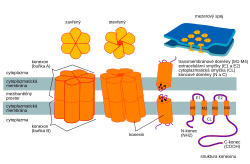Gap junctions
Gap junctions' (nexus or gap junction) is a type of junction between two adjacent cells at a point where their membranes are significantly close together. The connection is mediated by membrane channels, called connexons.
Connexon is a half-channel consisting of six molecules of connexin protein. The connexon of one cell fits precisely into the connexon of the neighbouring cell, creating a hydrophilic channel of 1.5 nm diameter that permeates ions and numerous organic substances up to 1 kDa in size (e.g. ATP, ADP, AMP, amino acids, Ca2+). Cells are well connected metabolically and electrically by gap junctios. In the event of damage to one cell (e.g. when the intracellular concentration rises Ca2+) the channel will be closed quickly. This disconnects the damaged cell from the neighbouring cells and prevents possible damage.
Gap junctions do not play a role in cell adhesion, they are used to transfer information between neighbouring cells (e.g. electrical signals, chemical messengers, etc.).
References[edit | edit source]
Related articles[edit | edit source]
Source[edit | edit source]
- ŠVÍGLEROVÁ, Jitka. Gap junctions [online]. The last revision 18. 2. 2009, [cit. 12.11.2010]. <https://web.archive.org/web/20160416225257/http://wiki.lfp-studium.cz/index.php/Gap_junctions>.
Bibliography[edit | edit source]
- KONRÁDOVÁ, Václava. Funkční histologie. 2. edition. H & H, 2010. 291 pp. ISBN 80-86022-80-3.




